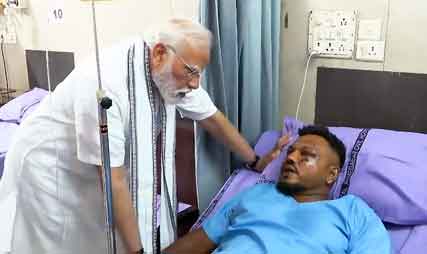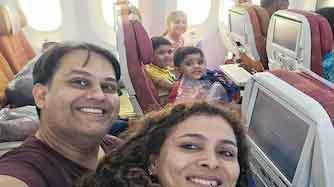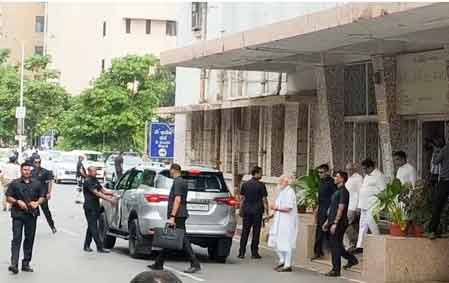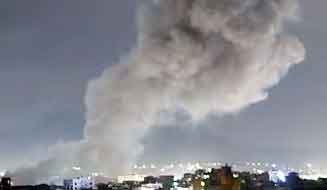The countdown for the July 14 afternoon launch of India’s third shot at the moon-Chandrayaan-3- will begin at 1.05 p.m. on Thursday, said a senior official of the Indian space agency.
“The countdown for the Chandrayaan-3 will begin at 1.05 p.m. today (Thursday),” a senior official of Indian Space Research Organisation (ISRO) told IANS.
The Chandrayaan-3 spacecraft will be carried by India's heavy lift rocket the 642 ton LVM3.
At 2.35 p.m. on July 14, the three stage LVM3 rocket will blast off from the second launch pad at Sriharikota rocket port in Andhra Pradesh.
During the countdown process, the liquid and cryogenic stages will be fueled up and the rocket systems checked.
While the first rocket’s first stage is powered by solid fuel, the second stage is by liquid fuel and the third and final stage consists of a cryogenic engine powered by liquid hydrogen and liquid oxygen.
At the time of blast off, the 642 ton rocket will be having a total propellant mass of 553.4 ton-all three stages put together.
Just over 16 minutes into its flight, the rocket will eject the Chandrayaan-3 spacecraft at an altitude of about 179 km.
After that, the Chandrayaan-3 will begin its own long moon journey of about 3.84 lakh km.
The lander carried by the spacecraft is expected to make a soft-landing on the moon on August 23 or 24.
The Chandrayaan-3 spacecraft comprises a propulsion module (weighing 2,148 kg), a lander (1,723.89 kg) and a rover (26 kg), said Indian Space Research Organisation (ISRO).
Incidentally, the Chandrayaan-2 payload weighed about 3.8 ton with the orbiter weighing 2,379 kg, the Vikram lander 1,444 kg, including the Pragyan rover 27 kg. The main purpose of Chandrayaan-3 is to safely land the lander on the moon soil.
Following that a rover will roll out to do the experiments. The life of the payload carried by the propulsion module post ejection of the lander is between three and six months.
On the other hand, the mission life of the lander and the rover is 1 Lunar day or 14 earth days, ISRO said.
According to the Indian space agency, the propulsion module has Spectro-polarimetry of Habitable Planet Earth (SHAPE) payload to study the spectral and Polari metric measurements of Earth from the lunar orbit.
The lander payloads are: Chandra’s Surface Thermophysical Experiment (ChaSTE) to measure the thermal conductivity and temperature; Instrument for Lunar Seismic Activity (ILSA) for measuring the seismicity around the landing site; Langmuir Probe (LP) to estimate the plasma density and its variations.
A passive Laser Retroreflector Array from NASA is accommodated for lunar laser ranging studies. On the other hand, the rover will carry: Alpha Particle X-ray Spectrometer (APXS) and Laser Induced Breakdown Spectroscope (LIBS) for deriving the elemental composition in the vicinity of the landing site, ISRO said.
The Indian space agency said, the moon mission is divided into three phases – the earth centric phase (Pre-Launch, Launch and Ascent and Earth-bound Manoeuvre), the Lunar Transfer Phase (Transfer Trajectory) and the Moon Centric Phase (Lunar Orbit Insertion Phase, Moon-bound Manoeuvre Phase, Propulsion Module and Lunar Module Separation, De-boost Phase, Pre-landing Phase, Landing Phase, Normal Phase for Lander and Rover, Moon Centric Normal Orbit Phase (100 km circular orbit) for Propulsion Module).
During the first phase, India’s heavy lift rocket standing 43.5 metre height and weighing 642 ton LVM3, will carry the Chandrayaan-3 spacecraft.
The rocket has an impeccable record of six consecutive successful missions.
This is the fourth operational flight of LVM3, and aims to launch the Chandrayaan-3 spacecraft to Geo Transfer Orbit (GTO).
The Friday moon mission is a follow up of the failed Chandrayaan-2 mission in 2019 when the lander named Vikram crashed on to the moon surface.
As regards the changes made in the lander this time as compared to the one that crash landed on the moon during the Chandrayaan-2 mission, a senior ISRO official told IANS that the lander has four motors instead of five.
The space agency has also carried out some changes in the software.
Interestingly, ISRO is silent on naming the lander and rover this time around.
During the Chandrayaan-2 mission, the lander was named as Vikram and rover as Pragyan.






Tripura has begun experimental soilless hydroponic farming: Minister
The Tripura government has experimentally started the hydroponics method of cultivation without any soil, the state’s agriculture minister Ratan Lal Nath said here on Friday.
Assam Rifles seized cannabis worth Rs 30 lakh from Tripura
In a swift and decisive operation against narcotics smuggling, Assam Rifles, in close coordination with representatives of the Directorate of Revenue Intelligence (DRI), successfully seized approximately 195 kg of marijuana from the general area of Taranagar, Agartala during the early hours of 12 June.
High-Level Meeting Held to Curb Illegal Infiltration in Tripura
A high-level administrative meeting was held today at the state secretariat under the chairmanship of Chief Secretary J. K. Sinha, following the directives of Tripura Chief Minister Prof. (Dr.) Manik Saha, to review and strengthen measures against illegal infiltration in the state.
Agriculture minister announces development of 3 new paddy varieties in Tripura
The state agriculture and farmers welfare department minister Ratan Lal Nath on Friday announced development of three new paddy varieties in Tripura, which can address the recurring flood-related challenges faced by farmers in the state.
CM Dr Manik Saha inaugurates state-of-the-art Cancer Care Unit in Agartala Private Run Hospital
Chief Minister Prof. (Dr.) Manik Saha on Friday inaugurated a state-of-the-art Cancer Care Center at a private run hospital in Agartala. The new center has been established in collaboration with the International Oncology Cancer Institute, aiming to make quality cancer treatment more accessible within the state.
‘I can’t believe I survived’, says lone survivor of Air India crash in emotional meeting with PM Modi
Prime Minister Narendra Modi on Friday met Vishwash Kumar Ramesh, the sole survivor of the devastating Air India plane crash. Ramesh, a British national of Indian origin, is recovering from injuries sustained in the crash and is being treated at a hospital in Ahmedabad.
Ahmedabad crash: Two Manipuri crew members of London-bound Air India flight killed
Two cabin crew members from Manipur - Kongbrailatpam Nganthoi Sharma (20) and Lamnunthem Singson (26) – were killed when the London-bound Air India flight, carrying over 240 passengers, crashed shortly after taking off from the Ahmedabad airport.
Doctor couple’s dreams of new beginning in UK turned to ashes
A doctor couple’s dreams of a new beginning together as a family in UK turned into a nightmare and their last trip together as the ill-fated flight that was to take them to London crashed seconds after take-off on Thursday.